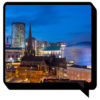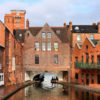Sample Exercise: “John Cadbury, a Brummie, founded a great chocolate company bearing his name.”
This dialect of central England is currently available ONLY by purchasing Accents & Dialects for Stage and Screen Deluxe Streaming Edition, the iTunes ebook (Apple Book) version of Accents & Dialects for Stage and Screen, or the iTunes ebook (Apple Book) version of Dialects of the British Isles.
Birmingham, with its roots in the sixth century, is a large, industrial city in England’s West Midlands, about 130 miles north of London. Birmingham lies on the eastern edge of what is called the “Black Country,” possibly named for the vast amounts of soot generated during the Industrial Revolution, or perhaps for a huge seam of coal lying quite close to the surface in that area.
Brummies, as natives of the city are affectionately known, live in the United Kingdom’s second most populous city, the UK’s “second city,” with roughly four million living in the wider metropolitan area. “Brummie” is taken from the city’s nickname, Brum, which comes from its ancient name, Brummagem, itself perhaps derived from Bromwich-ham. The Brummie dialect is very distinctive but not universally loved by Brits from other regions, and it is often stigmatized.
Like all large cities, Birmingham is home to a diverse population, so to speak about “the” Birmingham dialect is a gross simplification. More than half of school-age children are from non-white British families; over a quarter of residents of the city are of Asian descent, and the white population in the 2011 census was listed at 58 percent. Socio-economic profiles are as diverse as you would expect, with all the variety of speech styles that implies.
(Images above: Birmingham’s city centre is dominated by St. Martin in the Bull Ring and the Bull Ring Shopping Centre. The latter, containing Selfridge’s Department Store, was constructed in 2003 and is now an icon of Birmingham regeneration. St. Martin was built in 1873 but its tower and spire is several centuries older. iStockPhoto image #535429223 courtesy Chris Hepburn, www.chrishepburn.co.uk. Birmingham’s Gas Street Basin is part of the city’s famous network of canals. iStockPhoto image #178745760 courtesy of Tupungato.)





